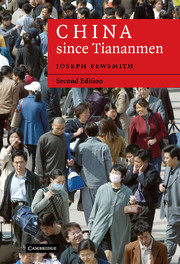Book contents
- Frontmatter
- Contents
- Acknowledgments
- Chronology
- Schematic overview of the Chinese political spectrum
- List of abbreviations and tables
- Introduction
- PART I LINE STRUGGLE REVISITED: THE ATTACK ON DENG'S REFORM PROGRAM
- 1 Tiananmen and the conservative critique of reform
- 2 Deng moves to revive reform
- PART II REDEFINING REFORM: THE SEARCH FOR A NEW WAY
- PART III ELITE POLITICS AND POPULAR NATIONALISM
- PART IV A NEW ERA IN CHINESE POLITICS
- Conclusion
- Epilogue: the Seventeenth Party Congress
- Bibliography
- Index
- Cambridge Modern China Series
2 - Deng moves to revive reform
Published online by Cambridge University Press: 05 September 2012
- Frontmatter
- Contents
- Acknowledgments
- Chronology
- Schematic overview of the Chinese political spectrum
- List of abbreviations and tables
- Introduction
- PART I LINE STRUGGLE REVISITED: THE ATTACK ON DENG'S REFORM PROGRAM
- 1 Tiananmen and the conservative critique of reform
- 2 Deng moves to revive reform
- PART II REDEFINING REFORM: THE SEARCH FOR A NEW WAY
- PART III ELITE POLITICS AND POPULAR NATIONALISM
- PART IV A NEW ERA IN CHINESE POLITICS
- Conclusion
- Epilogue: the Seventeenth Party Congress
- Bibliography
- Index
- Cambridge Modern China Series
Summary
By late 1990, Deng seemed visibly distraught by China's situation and his own inability to reassert his leadership. There were moments of small progress. For instance, in November he met with Jiang Zemin and Yang Shangkun before their trip to Shenzhen to commemorate the tenth anniversary of the SEZs' (Special Enterprise Zones) founding. This meeting no doubt accounts for Jiang's high evaluation of the zones at the meeting later that month. Then, on the eve of the Seventh Plenum in late December, Deng gave a short speech to several leaders emphasizing that planning and markets are not the distinguishing characteristics of socialism and capitalism, respectively. “Don't think that engaging in a little market economy is [taking] the capitalist road; it is not like that,” Deng told his colleagues. He also urged his colleagues to be bolder and to take some risks. These remarks evidently caused Jiang Zemin to revise his speech to the Seventh Plenum to declare that it was necessary to persist unswervingly in reform and opening up. One report indicates that Jiang made opening remarks to the plenum – but, if so, they have not been publicized; his closing remarks do contain a section called “firmly persist in reform and enlarge the scope of opening up.”
Such verbal reaffirmations of Dengist policy, however, did not amount to a resurrection of Deng's reform line.
- Type
- Chapter
- Information
- China since TiananmenFrom Deng Xiaoping to Hu Jintao, pp. 48 - 80Publisher: Cambridge University PressPrint publication year: 2008



